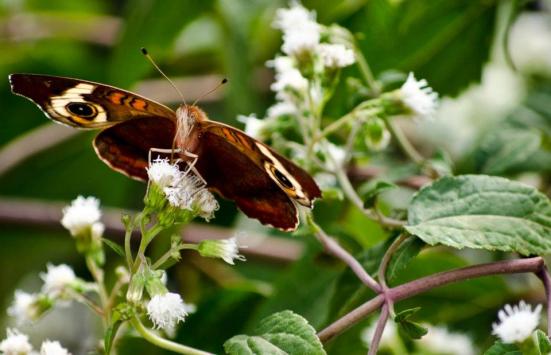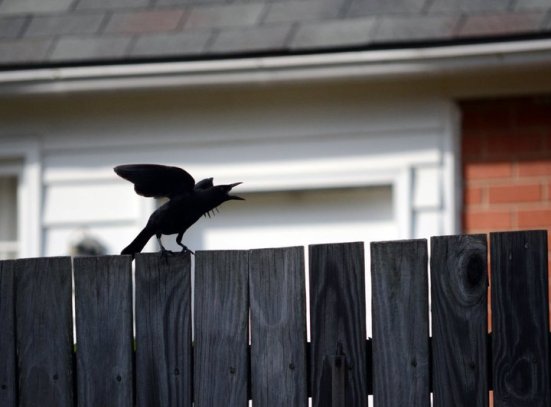This week’s photo challenge is Home: “share a picture that evokes HOME for you.“ Apart from my family–the one I was born to, and the one that grew around me over the years–my home is the garden that embraces our house.
When I garden, I imagine myself the Little Prince, tending his planet against the catastrophe of the baobabs. Last year, I joined the Wildlife Sanctuary Program with the Audubon Society of Northern Virginia, and that made me more observant and thoughtful about the environment I build. Here is my little planet and the creatures it shelters each year.
February – With the robins back, our feisty mockingbird resumes her war over holly dominance (she usually wins).
March – Couples begin to form, and nests spring up in the oddest of places.

Inevitably, I forget the old wreath, and Carolina wrens move in–right outside our front door
April –We notice our first chicks, usually Carolina chickadees and wrens.

A chickadee couple comes back to this cherry hollow every spring
Always within view, the wren nest soon explodes with tiny sounds. Happy story: Last year’s trio survived into adolescence (we lost track of them in mid-summer).

Carolina wren chicks
By late April, azaleas are in bloom, and everything around looks new and fresh.
If it is warm enough, a black rat snake slithers out for a sunbath.
And we even get an occasional mammal–in the least cultivated corner of the yard.
May – More nests! More babies hatch, and anxious, frantic parents begin the feeding frenzy.
Always a shock, the mulberry season arrives. Berry stains are a pain, but the birds these berries bring are worth the mess.

A red-bellied woodpecker on his daily visit
Toads and frogs make a gentle, unobtrusive appearance.

A Fowler’s toad, we think
And insects come into their own. I am especially happy to greet the lady beetles, my steadfast allies against aphids.
June – Native wildflowers are teeming with bees, butterflies, and a myriad of other winged creatures. Every morning, we awaken to birdsong.

There is always buzzing around butterfly weed blooms

A spicebush swallowtail resting after visiting our spice bush, its host plant

An early phlox bloom opens up for its first customer

One of my favorite crooners, a gray catbird
Last month’s chicks are now juveniles and the same size as their parents, but looking decidedly under-baked, haphazard. They cry out for food and are promptly satisfied by their exhausted caregivers.
July – Just as the entire DC area turns into an insufferable sauna, EVERYthing blooms and buzzes in the yard. Charismatic garden visits occur daily.

An Eastern tiger swallowtail on purple phlox

A monarch butterfly and a bee feast on early swamp milkweed blooms

A ruby-throated hummingbird and her obedient plants
August – Virginia gardens begin to look a tad tired and thirsty, but many native plants are just reaching their crescendo. A family of ruby-throated hummingbirds–we usually see several in our garden, an unusual sight for these territorial creatures, so we assume they are related–attack the scarlet cardinal flowers twice daily.
American goldfinches and other small birds descend on black-eyed susans and coneflowers, their seeds now quickly ripening.
September – Days begin to cool. Hardy asters take over, but August stars are still present. I watch milkweeds with particular zeal this month: The generation of monarch caterpillars that are devouring them now are the Methuselah generation, the only monarch cohort that lives up to nine months, enough to travel across the country to the same oyamel fir grove in Mexico. You can help this grand migration, so vulnerable to habitat loss, by supporting The Monarch Watch and joining its Monarch Waystation Program.
Chipmunks, whom we’ve hardly seen through summer, are now back in view, swift and gratuitously cute.
October – Rough clouds of white snakeroot flowers swathe my garden, still bright and buzzing with activity–the last hurrah before the cold season.

A common buckeye butterfly on white snakeroot
November – A trace of winter is in the air. The leaves are falling, flowers turn brown, and we come to know the squirrels by name.
Migrants from the north stop by. We are grateful to get a glimpse of them, if only for a few days.

An ovenbird, the resident of Eastern forests
And we get to see our regulars at a far closer range.
December – The garden sleeps. Bright holly berries are the toast of winter.
As it gets cold, a hawk begins to pay menacing visits.
 January – Another year begins, weeks of grey still ahead. Life in the yard goes on.
January – Another year begins, weeks of grey still ahead. Life in the yard goes on.
We peer out, restlessly, counting minutes to spring.
Read on:
























Wow!!! Amazing photos! 🙂
Thank you! I had fun looking over these–still two months before I can be back in the garden again…
I hope to get out into mine in the next month. At least add some amendments to the soil…then plant in April. 🙂
Do all these creatures inhabit your garden? You must be a lucky – and wonderful – person! I would have liked to visit too had I been closer to your country. Wonderful pictures.
Thank you so much for your kind words. They do all live or come for visits in my garden. I decided to try and plant native flowers and bushes, where I can–and it really pays off. I now have a whole different definition of “ornamental plants” (a.k.a., do their leaves host local butterflies and beneficial insects? Do their flowers attract birds and pollinators? It’s a different way to look at a garden, one I am enjoying much more–I actually LIKE to see eaten leaves now). I loved your pictures of home too. There is so much warmth and light in them.
what great photos! ^^
Thank you, Kz. Kind of you to stop by.
As good as joining the National Audubon Foundation! I’m saving this one for leisurely viewing while we’re housebound by 2 feet of snow!
Thank you–that’s a grand compliment! I hope Nemo is kind to you, and thank you very much for stopping by.
Pingback: Weekly Photo Challenge: Home | Wings to Fly
Pingback: Weekly Photo Challenge: Home « What's (in) the picture?
What a wonderful photo essay. Love the squirrel shots!
Thank you, Elen! Our squirrels are a year-around joy. The neighbors must hate us, but they are so engaging, and, to be honest, now that we give them tribute in nuts and provide food sources in the garden, I almost never lose bulbs to their digging.
Beautiful photos! How neat to see them all so close!
Thank you! To my great joy, after a little while, we became just part of the landscape for them, so getting close was not an issue.
Great photos! Is that squirrel doing a one-arm pushup?
On closer inspection, it’s even better. It’s a chipmunk doing a one-arm pushup.
It is! He is the most photogenic one of the lot.
The chipmunk with peanuts photo is amazing. It’s like he’s posing for you. And the kitty pic: what a gorgeous face.
The chipmunk, I do think, poses by now! Partly for us, partly for the cat. It’s like her private Nature channel.
This is a great photo essay! I followed you here from another blog because I liked your name, and found out we are neighbors. You’ve done a great job of showing the good things about living around here…easy to overlook with all the political drama. I’ll come back to visit again.
Greetings from Anne Arundel County!
Thank you for stopping by! I do love this area and am glad to be able to share something you liked. I look forward to your posts, neighbor.
Pingback: Weekly Photo Challenge Home, Love, Valentines Day « 2013 Weekly Photo Challenge Blog
Pingback: Photo Project: 52 Bolivian Sundays [week 6, 'Home']. « 3rdculturechildren
Pingback: Travel Theme: Deep | Transplanted Tatar
Pingback: Counting Pigeons | Transplanted Tatar
Pingback: Travel Theme: Pale | Transplanted Tatar
Pingback: Our Backyard Weekend: The Hatchlings! | Transplanted Tatar